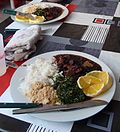Brazilian cuisine
Brazilian cuisine is a rich, diverse and exciting blend of influences from its native people, Portuguese colonists, African slaves, and immigrants from Europe, the Middle East, and Asia. Each of Brazil's regions has its own distinctive cuisine, featuring local ingredients and techniques.
History[edit]
The cuisine of Brazil has been shaped by a complex history of colonization, slavery, and immigration. The indigenous peoples of Brazil, such as the Tupi, Tapuia, and Guarani, had diets based on cassava, corn, beans, and local fruits and game. With the arrival of the Portuguese in the 16th century, new ingredients such as rice, onions, and garlic were introduced, along with livestock and dairy products. The Portuguese also brought African slaves to Brazil, who contributed their own culinary traditions, including the use of palm oil and okra.
In the 19th and 20th centuries, waves of immigrants from Italy, Germany, Spain, Japan, the Middle East, and other regions brought new foods and cooking styles to Brazil. These influences have all combined to create a unique Brazilian cuisine that is as diverse as its people.
Regional Cuisine[edit]
Brazil's vast size and diverse geography have led to the development of regional cuisines that vary greatly from one area to another.
Northern Brazil[edit]
The cuisine of Northern Brazil, including the states of Amazonas, Pará, and Acre, is heavily influenced by the indigenous peoples of the Amazon rainforest. Fish, especially the pirarucu and the tambaqui, are a staple, as are fruits like açaí, cupuaçu, and graviola.
Northeastern Brazil[edit]
In the Northeast, the cuisine is influenced by African, indigenous, and Portuguese cuisines. Dishes like vatapá, acarajé, and moqueca are common, as are foods made from manioc, such as farofa and tapioca.
Southeastern Brazil[edit]
The Southeast, which includes the states of São Paulo and Rio de Janeiro, is known for its pizza, pastel, and feijoada, a black bean stew with pork. The region is also famous for its coffee.
Southern Brazil[edit]
In the South, the cuisine is heavily influenced by Italian and German immigrants. Dishes like churrasco, a type of barbecue, and the Italian-style pastas and sausages are common.
Notable Dishes[edit]
Some notable dishes in Brazilian cuisine include:
- Feijoada: A hearty black bean stew with pork, served with rice, collard greens, farofa, and orange slices.
- Acarajé: A deep-fried ball of black-eyed pea dough, filled with vatapá and shrimp.
- Pão de queijo: A small, baked cheese roll, a popular snack and breakfast food.
- Brigadeiro: A sweet, chocolate truffle-like treat, often served at parties.
See Also[edit]
Ad. Transform your life with W8MD's Budget GLP-1 injections from $75


W8MD offers a medical weight loss program to lose weight in Philadelphia. Our physician-supervised medical weight loss provides:
- Weight loss injections in NYC (generic and brand names):
- Zepbound / Mounjaro, Wegovy / Ozempic, Saxenda
- Most insurances accepted or discounted self-pay rates. We will obtain insurance prior authorizations if needed.
- Generic GLP1 weight loss injections from $75 for the starting dose.
- Also offer prescription weight loss medications including Phentermine, Qsymia, Diethylpropion, Contrave etc.
NYC weight loss doctor appointmentsNYC weight loss doctor appointments
Start your NYC weight loss journey today at our NYC medical weight loss and Philadelphia medical weight loss clinics.
- Call 718-946-5500 to lose weight in NYC or for medical weight loss in Philadelphia 215-676-2334.
- Tags:NYC medical weight loss, Philadelphia lose weight Zepbound NYC, Budget GLP1 weight loss injections, Wegovy Philadelphia, Wegovy NYC, Philadelphia medical weight loss, Brookly weight loss and Wegovy NYC
|
WikiMD's Wellness Encyclopedia |
| Let Food Be Thy Medicine Medicine Thy Food - Hippocrates |
Medical Disclaimer: WikiMD is not a substitute for professional medical advice. The information on WikiMD is provided as an information resource only, may be incorrect, outdated or misleading, and is not to be used or relied on for any diagnostic or treatment purposes. Please consult your health care provider before making any healthcare decisions or for guidance about a specific medical condition. WikiMD expressly disclaims responsibility, and shall have no liability, for any damages, loss, injury, or liability whatsoever suffered as a result of your reliance on the information contained in this site. By visiting this site you agree to the foregoing terms and conditions, which may from time to time be changed or supplemented by WikiMD. If you do not agree to the foregoing terms and conditions, you should not enter or use this site. See full disclaimer.
Credits:Most images are courtesy of Wikimedia commons, and templates, categories Wikipedia, licensed under CC BY SA or similar.
Translate this page: - East Asian
中文,
日本,
한국어,
South Asian
हिन्दी,
தமிழ்,
తెలుగు,
Urdu,
ಕನ್ನಡ,
Southeast Asian
Indonesian,
Vietnamese,
Thai,
မြန်မာဘာသာ,
বাংলা
European
español,
Deutsch,
français,
Greek,
português do Brasil,
polski,
română,
русский,
Nederlands,
norsk,
svenska,
suomi,
Italian
Middle Eastern & African
عربى,
Turkish,
Persian,
Hebrew,
Afrikaans,
isiZulu,
Kiswahili,
Other
Bulgarian,
Hungarian,
Czech,
Swedish,
മലയാളം,
मराठी,
ਪੰਜਾਬੀ,
ગુજરાતી,
Portuguese,
Ukrainian














